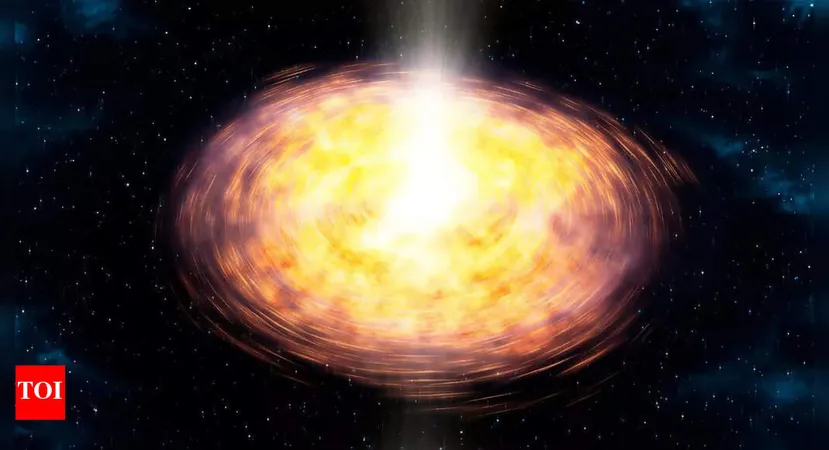
A Hidden Giant: What Scientists Discovered Deep Within Earth Will Change Everything
2025-08-15
Author: John Tan
A Planetary Mystery Unraveled
Deep beneath our feet, in the mysterious D" layer of Earth's mantle, something extraordinary is happening. Researchers from ETH Zurich have made a jaw-dropping discovery: solid rock can actually move like a fluid without melting. This groundbreaking revelation promises to redefine our understanding of Earth's dynamics.
Peering into the Depths
Sitting approximately 2,700 kilometers (1,700 miles) beneath the Earth's surface, the D" layer—the boundary between the lower mantle and the outer core—has puzzled scientists for decades. Known for its unusual seismic characteristics, this enigmatic region has sparked intrigue and debate about its composition. Now, with a revolutionary study led by Professor Motohiko Murakami, we gain new insights into this critical layer of our planet.
The Game-Changing Experiment
Using advanced diamond anvil cells and X-ray diffraction, the research team simulated the immense pressures and temperatures of the D" layer, revealing how minerals there behave under such extreme conditions. By studying magnesium germanate—an easier stand-in for mantle minerals—the team was able to observe how these solid rocks form and flow over geological timescales.
Post-Perovskite: A Key Player
A central figure in this study is post-perovskite, a high-pressure variant of the mineral perovskite. This mineral possesses unique structural properties that enable it to align and deform under stress, allowing it to flow like a viscous liquid. Such dynamics play a crucial role in mantle convection, the slow movement that drives tectonic plate activity.
Breaking Down Seismic Wave Mysteries
One of the most significant breakthroughs of this research is the explanation for why seismic waves can travel up to seven percent faster through certain parts of the D" layer. The unique alignment of post-perovskite alters how these waves propagate, linking the intricate behaviors of deep minerals with surface-level seismic readings.
Implications for Our Planet
The findings have profound implications for plate tectonics and volcanism. The directional alignment of post-perovskite can steer mantle plumes—hot columns of rock—toward the upper mantle, fostering volcanic hotspots like those found in Hawaii and Iceland. Additionally, this movement influences mountain range formation and activities along subduction zones where tectonic plates collide.
Connecting to Earth's Magnetic Heart
Beyond geology, this research sheds light on Earth's magnetic field's generation. The heat distribution from the deep mantle to the outer core plays a pivotal role in driving convection within the liquid iron core, which is vital for magnetic field stability. By detailing how the D" layer transfers heat through solid-state flow, the study establishes a crucial link between Earth's interior processes and its magnetic dynamics over the last 200 million years.
Revolutionizing Earth Science
The implications of this study for Earth science are profound. It offers a richer model of mantle convection and its impact on surface geology, explains seismic anomalies in the D" layer, enhances our understanding of heat transfer between Earth's core and mantle, provides clarity on mantle plume formation and volcanic activity, and reveals connections between deep Earth processes and the magnetic field.
Final Thoughts
As scientists continue to unravel the mysteries lurking beneath our planet, discoveries like this remind us of the dynamic processes driving Earth’s behavior. The unveiling of the D" layer’s intricacies is not just an academic exercise; it has far-reaching consequences for our understanding of geology, volcanism, and even the stability of Earth's magnetic field.



 Brasil (PT)
Brasil (PT)
 Canada (EN)
Canada (EN)
 Chile (ES)
Chile (ES)
 Česko (CS)
Česko (CS)
 대한민국 (KO)
대한민국 (KO)
 España (ES)
España (ES)
 France (FR)
France (FR)
 Hong Kong (EN)
Hong Kong (EN)
 Italia (IT)
Italia (IT)
 日本 (JA)
日本 (JA)
 Magyarország (HU)
Magyarország (HU)
 Norge (NO)
Norge (NO)
 Polska (PL)
Polska (PL)
 Schweiz (DE)
Schweiz (DE)
 Singapore (EN)
Singapore (EN)
 Sverige (SV)
Sverige (SV)
 Suomi (FI)
Suomi (FI)
 Türkiye (TR)
Türkiye (TR)
 الإمارات العربية المتحدة (AR)
الإمارات العربية المتحدة (AR)